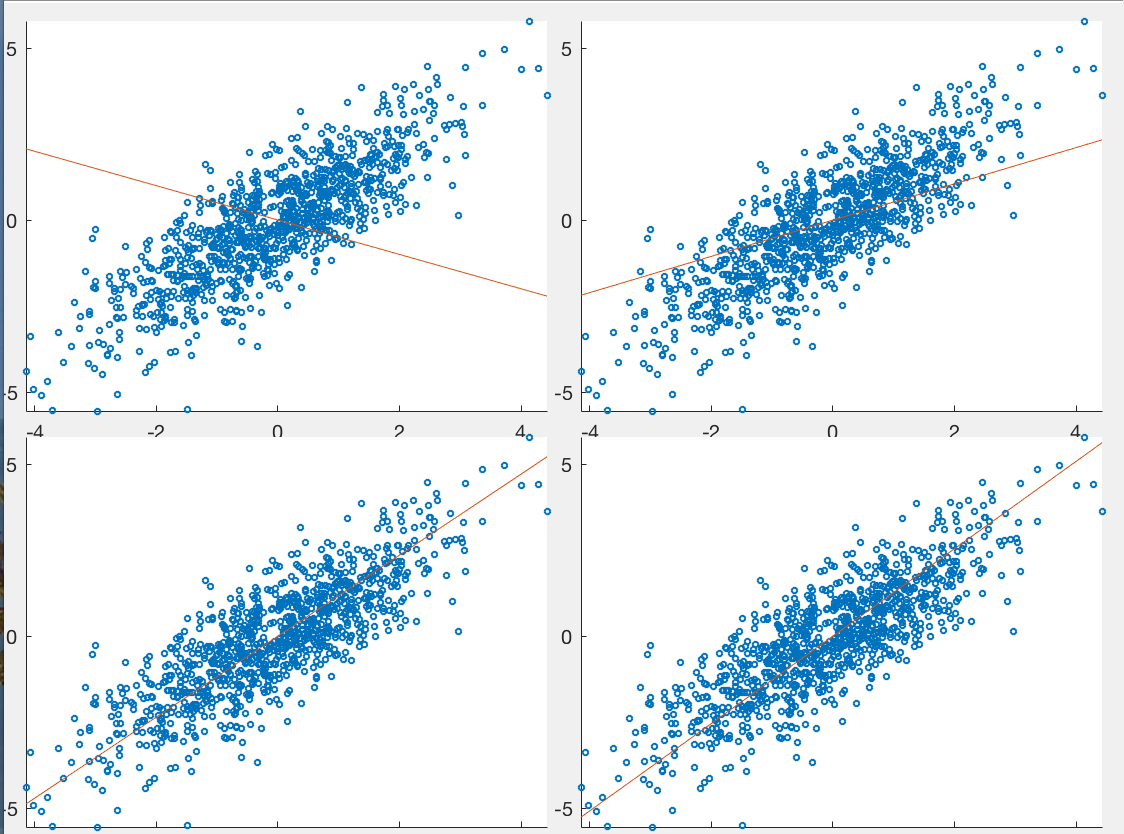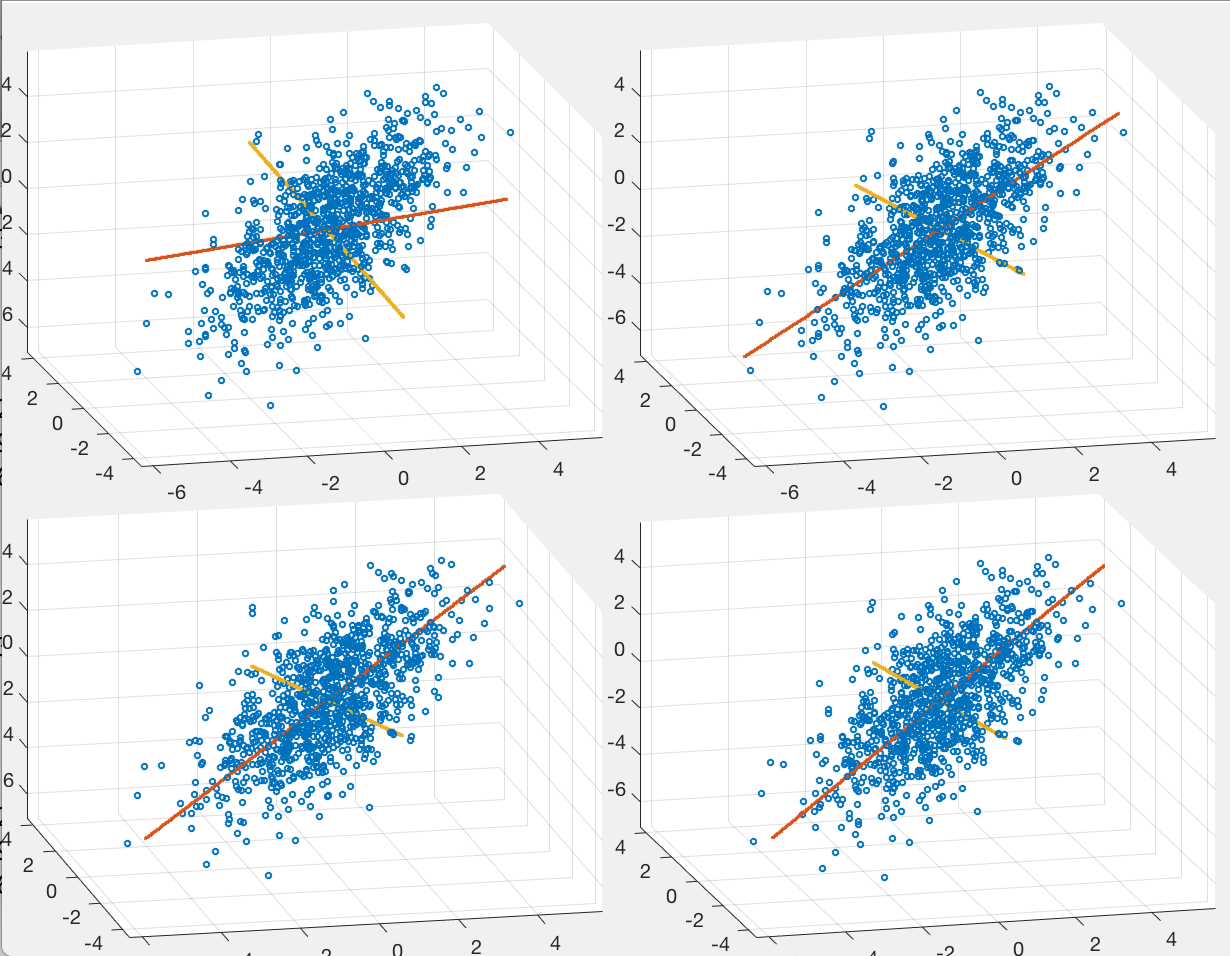Next: Classical Multidimensional Scaling Up: ch8 Previous: Factor Analysis and Expectation
The method of probabilistic PCA (PPCA) can be considered
as a special case of factor analysis based on the model




Same as in Eqs. (125) and (127) for FA, here
we also have the normal distribution of both 

 |
(150) |
 , same as in Eq. (131):
, same as in Eq. (131):
 |
(151) |
 and
and  as
the model parameter, based on the observed data dataset
as
the model parameter, based on the observed data dataset
![${\bf X}=[{\bf x}_1,\cdots,{\bf x}_N]$](img6.svg) .
.
Now Eqs. (137) through (139) are rewritten as:
 |
(153) |
 |
(154) |
The two steps of the EM algorithm become:
 in Eq. (142) by
in Eq. (142) by
 :
:
![$\displaystyle Q =-\frac{dN}{2}\log\varepsilon-\frac{1}{2\varepsilon}
\sum_{n=1}...
... {\bf x}_n^T{\bf x}_n -2{\bf x}_n^T{\bf Wz}
+{\bf z}^T{\bf W}^T{\bf Wz} \right]$](img571.svg) |
(155) |
 and
and
 that maximize the expectation of the log likelihood
that maximize the expectation of the log likelihood
 above, by setting the derivative of
above, by setting the derivative of  with respect to the
parameters to zero and solve the resulting equations. For
with respect to the
parameters to zero and solve the resulting equations. For  ,
the result is the same as Eq. (145):
where
To find
,
the result is the same as Eq. (145):
where
To find
 , we solve the equation
, we solve the equation
![$\displaystyle \frac{\partial Q}{\partial \varepsilon}
=-\frac{dN}{2\varepsilon}...
...f x}_n^T{\bf x}_n -2{\bf x}_n^T {\bf Wz}
+ {\bf z}^T{\bf W}^T{\bf Wz} \right]=0$](img574.svg) |
(158) |
 .
.
In summary, here are the steps in the EM algorithm for PPCA:
 ;
;
 , find
, find
 and
and
 in Eq. (152), and
in Eq. (152), and
 and
and
 in Eq. (157);
in Eq. (157);
 by evaluating Eqs. (156) and (159);
by evaluating Eqs. (156) and (159);
 by
by
 and return to step 2.
and return to step 2.
Specially, if we further assume






 with Eq. (81)
with Eq. (81)
 |
(161) |
![${\bf W}=[{\bf w}_1,\cdots,{\bf w}_{d'}]$](img588.svg) for the PPCA are similar to the column vectors of
for the PPCA are similar to the column vectors of  , the
eigenvector matrix of
, the
eigenvector matrix of
 , in the linear PCA, as both of
them can be viewed as the principal directions, an alternative set of
basis vectors that also span the same d-dimensional feature space in
which
, in the linear PCA, as both of
them can be viewed as the principal directions, an alternative set of
basis vectors that also span the same d-dimensional feature space in
which  resides. When
resides. When  is expressed as a linear
combination of these basis vectors, it can be approximated by only
is expressed as a linear
combination of these basis vectors, it can be approximated by only
 of the
of the  such basis vectors weighted by the
such basis vectors weighted by the  principal
components in
principal
components in
![${\bf y}=[y_1,\cdots,y_{d'}]^T$](img589.svg) in linear PCA, or the
in linear PCA, or the
 factors in
factors in
![${\bf z}=[z_1,\cdots,z_{d'}]^T$](img467.svg) in PPCA.
in PPCA.
Here are the two EM steps for the PPCA:
 , Eq. (152) can
be written as:
, Eq. (152) can
be written as:
 |
 |
 |
|
 |
 |
(162) |
 such equations can be written in matrix form as
such equations can be written in matrix form as
![$\displaystyle {\bf Z}=[{\bf z}_1,\cdots,{\bf z}_n]
={\bf W}^T({\bf WW}^T)^{-1}[{\bf x}_1,\cdots,{\bf x}_N]
={\bf W}^T({\bf WW}^T)^{-1}{\bf X}$](img594.svg) |
(163) |
 is a
is a
 matrix (
matrix ( ), the rank of
the
), the rank of
the  matrix
matrix
 is at most
is at most  , i.e., the
inverse of
, i.e., the
inverse of
 does not exist and we cannot find
does not exist and we cannot find
 . In
fact the transformation matrix
. In
fact the transformation matrix
 is the
right psedo inverse
of the
is the
right psedo inverse
of the
 matrix
matrix  , which exists only if
, which exists only if  .
.
However, we note that the model



![${\bf z}=[z_1,\cdots,z_{d'}]^T$](img467.svg)


 |
(164) |
![${\bf Z}=[{\bf z}_1,\cdots,{\bf z}_N]$](img413.svg) given all
given all  data points in
data points in
![${\bf X}=[{\bf x}_1,\cdots,{\bf x}_N]$](img6.svg) :
:
 |
(165) |
 previously estimated.
previously estimated.
 |
 |
 |
|
 |
![$\displaystyle [{\bf x}_1,\cdots,{\bf x}_N]\left[\begin{array}{c}
{\bf z}_1^T\\ ...
...d{array}\right]\right)^{-1}
={\bf X}{\bf Z}^T({\bf ZZ}^T)^{-1}={\bf X}{\bf Z}^-$](img605.svg) |
(166) |
 is uptated based on
is uptated based on  found previously
in the E-step. We note that
found previously
in the E-step. We note that
 is the right
pseudo inverse of the
is the right
pseudo inverse of the  matrix
matrix  , which exists
if
, which exists
if  .
.
Again, as the E-step and M-steps are interdependent on each other,
they need to be carried out iteratively:
| E-step: |  |
 |
|
| M-Step: |  |
 |
(167) |
 , the FA model
, the FA model
 can be expressed as an over-determined matrix
equation
can be expressed as an over-determined matrix
equation
![$\displaystyle {\bf X}_{d\times N}=[{\bf x}_1,\cdots,{\bf x}_N]
={\bf W}_{d\times d'}[{\bf z}_1,\cdots,{\bf z}_N]
={\bf W}_{d\times d'}{\bf Z}_{d'\times N}$](img612.svg) |
(168) |
 |
(169) |
 , this equation can be interpreted in two ways:
, this equation can be interpreted in two ways:
 is available, this is a system of
is available, this is a system of  equations
but
equations
but  unknowns in each of the
unknowns in each of the  columns of
columns of  , which
is solved as in the E-step above;
, which
is solved as in the E-step above;
 is available, this is a system of
is available, this is a system of  equations
but
equations
but  unknowns in each of the
unknowns in each of the  rows of
rows of  , which
is solved as in the M-step above.
, which
is solved as in the M-step above.
 .
.
When compared to the regular PCA method that finds all 



The implementation of the PPCA is extremely simple, as shown
in the Matlab code below. Based on some initialized 
while er>tol
Z=inv(W'*W)*W'*X; % find Z given W in E-step
Wnew=X*Z'*inv(Z*Z'); % find W given Z in M-step
er=norm(Wnew-W); % the LS error
W=Wnew;
end
Example 1:
The figure below shows the first few iterations of the PPCA based
on the EM method presented above, for a set of 
![${\bf X}=[{\bf x}_1,\cdots,{\bf x}_N]$](img6.svg)



Example 2:
The figure below shows the first few iterations of the PPCA EM
algorithm for a set of data points in 


Example 3:
The figure below shows the visualization of the dataset for
the hand-written numbers from 0 to 9, containing 2240 data
points in a 256-D space, but now linearly mapped to a 3-D
space spanned by 
